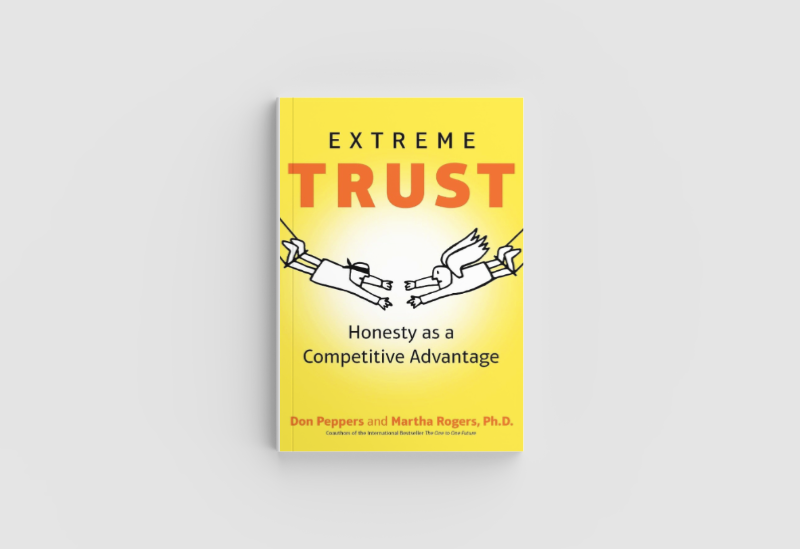Starting the Conversation about Investing in Volunteer Engagement
There’s a widespread myth that, in my experience, is the root of many of our sector’s biggest challenges. Far too many people (including leaders of...
4 min read
![]() Nicole R. Smith
Nov 22, 2024 5:39:38 PM
Nicole R. Smith
Nov 22, 2024 5:39:38 PM

This Month's Selection:
Extreme Trust: Honesty as a Competitive Advantage, by Don Peppers and Martha Rogers, Ph.D.
The twentieth in a series of Better Impact Book Bites
A taste of great books worth consuming.
This book was gifted to me by a supervisor after an interesting conversation we had where I divulged that I found it difficult to trust some of my coworkers. Truth be told, I didn’t read it then. Fast forward a few years, and the topic of trust has made its presence known in several different training rooms, meetings and various other circumstances, so I found it fitting to read the book now. I am so glad I did, and it reaffirms my strong belief in the fact that timing is everything.
Book Background Information: This book is 262 pages and available on Audible. The coauthors have authored 8 books together and are the founders of a global management consulting firm.
Chapter 1: Trust: Not Just a Good Idea. Inevitable – The book opens with the definitions and differences between trustworthy and trustable, and why “Yesterday, trustworthy was good enough. Today, only trustability will do.” It discusses the three basic principles of trustability: Do things right, do the right thing and be proactive. The thought that really stuck with me is this; “Peter Drucker referred to doing things right as “management.” Doing the right thing? He called that “leadership.” Powerful. Read that again.
Chapter 2: Serving the Interests of Customers, Profitably – This chapter discusses that companies that balance the best interest of their customers along with their own self-interest succeed at a higher rate. At first read, one would think “duh” but what I love is that it continues to share examples of the differences between a company that is trustworthy and trustable to help make what seems to be common sense even more clear. The chapter also explores the social role of empathy and trust, and introduces psychopathic capitalism.
Chapter 3: Trustability: Capitalist Tool – Chapter three blows off the fairy dust and gives it to you straight. Trustability is great, but what about the bottom line? The authors assure you that your CEO will buy-in to the concept for how well it benefits the bottom line because each customer “is like a tiny bundle of future cash flow [loyalty] with a memory.” It demonstrates how customer [client/volunteer] relationships are a link to long-term value.
Chapter 4: Sharing – Not Just for Sunday School – This chapter speaks about the power of social media and the fact that sharing is caring, not to mention a way to fulfill the deep seeded need that we all have for connection. It discusses how customer feedback can affect the perception of just how trustable a company or organization is. It was great to see the book acknowledge that “now that the technology is available, unpaid volunteers are in fact creating billions of dollars’ worth of time savings, entertainment, instruction, new information, and knowledge through a wider and wider variety of social production enterprises.” I am a sucker for any publication, especially outside of the nonprofit world, that confirms, validates and affirms what we in the volunteer engagement profession already know.
Chapter 5: Trust and the E-Social Ethos – This chapter introduces the philosophy of ARIA when it comes to building trust (Acknowledge, Recognition, Information and Access) in terms of the incredible impact influencers (in my personal opinion, volunteers) can have on your brand. Long story short, someone who has a meaningful, trusting experience with your company/organization, they will spread the word, not only to friends and family, but on their social networks, which can “speak” volumes.
Chapter 6: Control is Not an Option – Well, this is interesting. Did you know that psychopaths and control freaks are opposite sides of the same “coin”? One can’t be trusted and the other trusts no one. Leaders, listen up. Extending trust to others can be incredibly difficult, but in my favorite words, “if you want to grow, you gotta let go!” I love how this chapter breaks down the illusion of control and how being so controlling is actually wildly counterproductive. “Just because you aren’t controlling things, doesn’t mean that things aren’t in control or that chaos is inevitable.” I also found it fascinating that it discusses how some companies have employee autonomy as a KPI and suggests ROWE; a Results Only Work Environment. WHAT???
Chapter 7: Build Your Trustability in Advance – I feel validated as a person after reading this chapter because I have said over and over during numerous trainings, do what you say you are going to do. Keeping your word is one of the best ways to build trust. This chapter reiterates that we should “promise what we deliver and deliver what we promise” CONSISTENTLY. This chapter also digs deeper into trust as a competitive strategy.
Chapter 8: Honest Competence – Did you know competence helps to build trustability? It is one thing to promise to do something, but it is a completely different story if you actually have the competence to fulfill what is promised and alluding to anything otherwise can be detriment to trustability. It discusses the difference between product competence and customer competence and why they need to be aligned.
Chapter 9: Trustable Information – Talk about an eye-opener! This chapter breaks down what trustable information is; “Information that has ‘good intentions’ is objective information and ‘competent’ information is information that is accurate.” I really like this litmus test of sorts that all information should pass through prior to being shared, especially on social media. After all, bad information on the internet is like trying to take “pee out of a swimming pool.” Ewe.
Chapter 10: Designing Trustability Into A Business – This chapter is full of practical tools to help build trustability into your business, such as reminding a customer that they have already purchased something if they were planning on purchasing it again, or reminders that warranties or rebates are soon to expire. It made me think, how can we use this same thought process in building trustability in our volunteer programs? It was a great way to end the book and leave one with the challenge on how to bake trustability into our programs.
One of the things I love about this book is that at the end of each chapter it asks a list of questions to help you determine if your practices are more self-serving than originally thought. In the similar spirit of Wonder Drug, it speaks ad nauseum as to why trustability is important and gives examples from several different industries. It is understandable though, because by the time you finish the book, without a doubt you will understand why trustability is so vital and from various industries and perspectives. At the end of the day, volunteer programs can benefit greatly from the principles offered in the book, especially due to the amount of self-reflection that has to be done to arrive at a trustable program, and in the end, everyone wins.
Featured Posts

There’s a widespread myth that, in my experience, is the root of many of our sector’s biggest challenges. Far too many people (including leaders of...

The idea of micro-volunteering is gaining traction, and for good reason. Fewer people are willing or able to commit to a regular shift. They want the...

Introduction In the world of volunteer engagement, dedicated individuals work tirelessly to develop impactful volunteer programs in support of their...